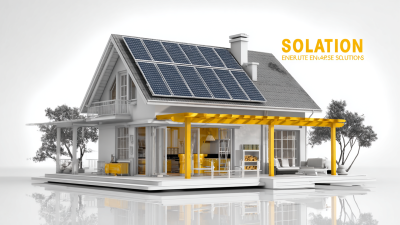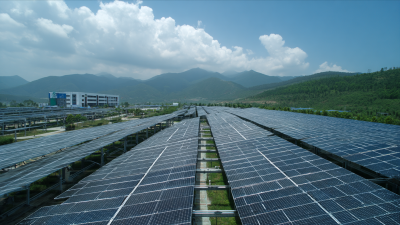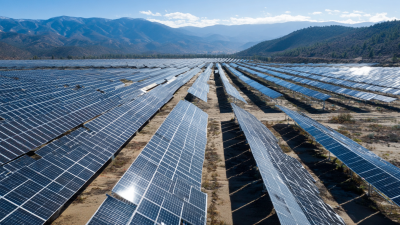
Blog
The Future of Solar Energy Solutions How Innovative Technologies Are Shaping a Sustainable Tomorrow
The increasing urgency for sustainable energy solutions has propelled solar energy solutions to the forefront of renewable energy discussions. As outlined in the International Energy Agency's (IEA) World Energy Outlook 2022, solar power is projected to become the world’s largest source of electricity by 2025, driven by rapidly decreasing costs and technological innovations. In fact, the levelized cost of electricity from solar photovoltaics (PV) has fallen by over 80% since 2010, making it a highly competitive alternative to fossil fuels. Furthermore, according to a recent report by Wood Mackenzie, global solar capacity is expected to surpass 4,000 gigawatts by 2025, a clear indication of the sector's significant growth. Innovations such as advanced energy storage systems, smart grid technology, and building-integrated photovoltaics are revolutionizing the way solar energy is harnessed and utilized, paving the way for a more sustainable tomorrow that promises to mitigate climate change while meeting the world’s ever-growing energy demands.

Innovative Photovoltaic Technologies Driving Efficiency Gains in Solar Panels
 Innovative photovoltaic (PV) technologies are at the forefront of transforming solar energy solutions, driving significant efficiency gains in solar panels. According to the International Energy Agency (IEA), the average efficiency of commercial solar panels has increased from around 15% in 2010 to over 20% by 2023. This leap is attributed to advancements in materials, such as perovskite solar cells, which have demonstrated efficiencies exceeding 25% in laboratory settings. These developments suggest a promising future for solar technology as manufacturers incorporate these materials into commercial products.
Innovative photovoltaic (PV) technologies are at the forefront of transforming solar energy solutions, driving significant efficiency gains in solar panels. According to the International Energy Agency (IEA), the average efficiency of commercial solar panels has increased from around 15% in 2010 to over 20% by 2023. This leap is attributed to advancements in materials, such as perovskite solar cells, which have demonstrated efficiencies exceeding 25% in laboratory settings. These developments suggest a promising future for solar technology as manufacturers incorporate these materials into commercial products.
Furthermore, the ongoing enhancements in bifacial solar panels, which capture sunlight on both sides, are reshaping solar energy harvesting. A report by Bloomberg New Energy Finance (BNEF) indicates that bifacial panels can boost energy generation by up to 30% compared to traditional monofacial panels. This increase not only optimizes land use but also makes solar installations more cost-effective over time. As these innovative technologies continue to evolve, they promise to play a crucial role in making solar energy a cornerstone of sustainable energy systems worldwide.
The Role of Energy Storage Solutions in Maximizing Solar Energy Utilization
Energy storage solutions play a pivotal role in maximizing the utilization of solar energy, particularly within hybrid energy systems designed for rural communities. Recent advancements in multi-agent systems are enabling more efficient management of energy demand and variability, integrating renewable sources with hybrid storage devices, such as batteries and hydrogen storage systems. A comprehensive review has shown that optimizing hybrid energy storage systems can effectively address the challenges faced by renewable energy sources, including intermittency and economic constraints.
For instance, innovative storage technologies not only enhance performance but also minimize energy wastage, thereby contributing to a more sustainable energy future.
Additionally, the integration of various energy storage materials in solar distillation systems has demonstrated significant improvements in performance. By utilizing diverse storage solutions, researchers are able to enhance the efficiency of solar energy capture and utilization.
Techno-economic optimization studies indicate the potential for hybrid renewable systems to lower costs while maximizing output, a critical component for the widespread adoption of these technologies. As the industry continues to evolve, the importance of energy storage in overcoming the barriers to large-scale renewable energy deployment becomes increasingly clear, paving the way for a truly sustainable future.
Smart Grid Integration: Enhancing Solar Power Distribution through Digital Solutions
The integration of smart grids into solar power distribution represents a significant leap forward in optimizing energy efficiency and reliability. With the rise of digital technologies, smart grids enhance the management of solar energy production and consumption in real-time. By incorporating advanced sensors, automated controls, and data analytics, these systems can balance energy supply and demand more effectively, reducing wastage and ensuring that solar energy is utilized to its full potential.
Moreover, smart grid technology facilitates decentralized power generation, allowing households and businesses with solar panels to contribute energy back to the grid. This creates a more resilient energy network that can adapt to fluctuating demands and the intermittent nature of solar energy. By harnessing innovations such as blockchain for energy transactions and artificial intelligence for predictive analytics, smart grids significantly improve the way solar energy is distributed and consumed, paving the way toward a sustainable and energy-efficient future.
The Future of Solar Energy Solutions
This bar chart illustrates the capacity growth of solar energy installations across different regions over the last five years. It highlights how innovative technologies, including smart grid integration, are enhancing solar power distribution, contributing to a sustainable energy future.
Emerging Solar Market Trends: Projections for Growth and Investment Opportunities
The solar energy market is witnessing a paradigm shift as emerging technologies drive significant growth and investment opportunities. According to a report by the International Renewable Energy Agency (IRENA), solar capacity is expected to increase by as much as 1,000 GW by 2025, reflecting a compound annual growth rate (CAGR) of 18%. This rapid expansion is fueled by technological advancements such as bifacial solar panels and perovskite materials, which promise higher efficiency and lower production costs.
In addition to technological innovations, favorable government policies and increased corporate investments are also propelling the solar market forward. A recent study by BloombergNEF indicates that global solar investments could reach $2.7 trillion over the next decade, driven by large-scale utility projects and decentralized solar solutions. As nations strive to meet their climate targets, market trends show a growing preference for solar as a primary energy source, paving the way for a more sustainable and renewable energy landscape.
Sustainable Materials in Solar Energy: Innovations Reducing Environmental Impact
As we look towards a sustainable future, the integration of innovative materials in solar energy solutions is paramount. Recent advancements have seen the emergence of biodegradable and recyclable components in solar panels, which significantly reduce the environmental impact during both production and disposal. By utilizing materials such as organic photovoltaics and perovskites, manufacturers can create solar cells that not only harness energy more efficiently but also adhere to eco-friendly practices.
Tips for choosing sustainable solar materials include researching the lifecycle of the products, prioritizing manufacturers who focus on circular economy principles, and seeking certifications that verify the use of non-toxic and sustainable materials. Additionally, considering the end-of-life options for solar panels can guide consumers toward more environmentally responsible choices.

Innovations like transparent solar cells and solar skins are also paving the way for more aesthetically pleasing installations, allowing buildings to blend solar technology seamlessly with design. By investing in these emerging technologies, we can enhance energy production while minimizing ecological footprints, heralding a new era of sustainable energy solutions.
Related Posts
-

Unlocking the Advantages of the Best Solar Energy Solutions for Sustainable Living
-

Uncover the Excellence of Best Solar Engineering from Chinas Leading Manufacturers
-

Navigating Industry Standards: Challenges in Sourcing the Best Green Solar Panels Globally
-

Understanding the Importance of Solar Green Technology in Sustainable Energy Solutions
-

Top Green Solar Power Solutions for Ultimate Energy Efficiency Comparison
-

Innovative Green Energy Alternatives Shaping the Future of 2025 Technology Trends